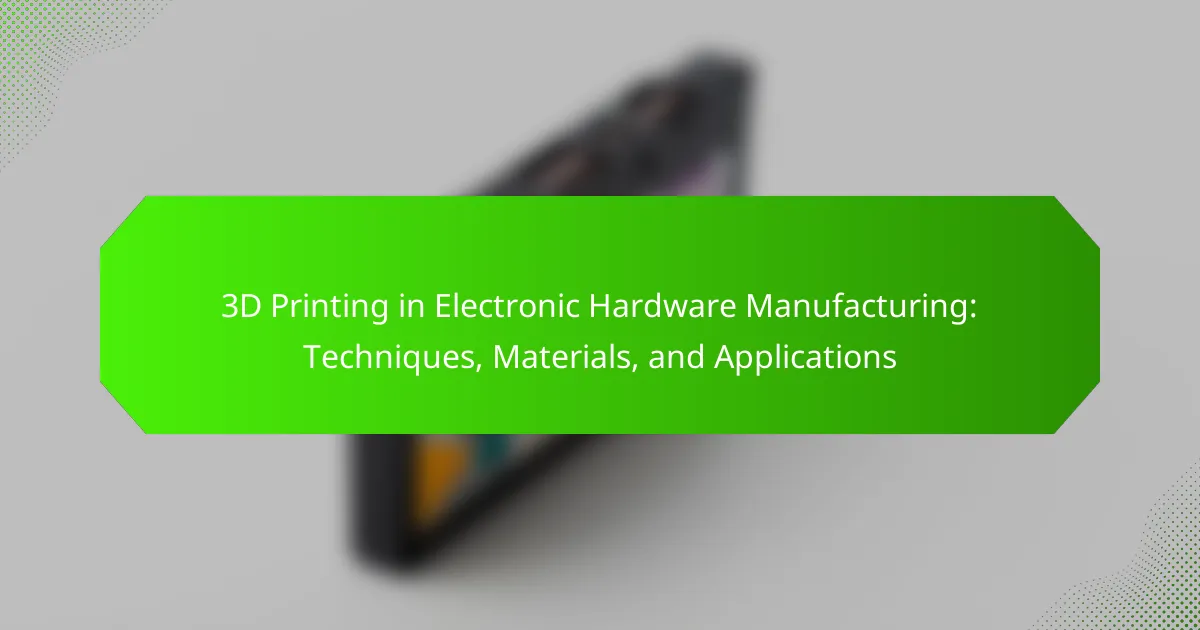3D printing in electronic hardware manufacturing is a transformative process that creates three-dimensional objects from digital models, enabling the production of complex geometries using materials such as polymers, metals, and ceramics. Key techniques include Fused Deposition Modeling (FDM), Stereolithography (SLA), and Selective Laser Sintering (SLS), each serving distinct purposes in prototyping and final product manufacturing. The technology allows for rapid prototyping, custom tooling, and the integration of multiple functions into single components, enhancing efficiency and reducing development timelines. With the 3D printing market projected to reach $35.6 billion by 2024, advancements in materials and techniques are driving significant growth in the electronic hardware sector.

What is 3D Printing in Electronic Hardware Manufacturing?
3D printing in electronic hardware manufacturing is a process that creates three-dimensional objects from digital models. This technology allows for the production of complex geometries that are difficult to achieve with traditional manufacturing methods. It utilizes materials such as polymers, metals, and ceramics to construct electronic components. The process enables rapid prototyping, reducing development time significantly. According to a study by Wohlers Associates, the 3D printing market in manufacturing is projected to reach $35.6 billion by 2024. This growth is driven by advancements in materials and printing techniques tailored for electronics.
How does 3D printing integrate into electronic hardware manufacturing?
3D printing integrates into electronic hardware manufacturing by enabling rapid prototyping and customization of components. This technology allows manufacturers to create complex geometries that traditional methods cannot achieve. For instance, 3D printing can produce intricate circuit boards and enclosures tailored to specific designs. It reduces material waste by using additive manufacturing processes. Additionally, 3D printing facilitates the integration of multiple functions into a single component. This streamlines production and shortens lead times. According to a study by Wohlers Associates, 3D printing in electronics can reduce prototyping time by up to 90%. This significant time-saving enhances innovation and responsiveness in product development.
What are the foundational technologies behind 3D printing?
The foundational technologies behind 3D printing include Fused Deposition Modeling (FDM), Stereolithography (SLA), and Selective Laser Sintering (SLS). FDM uses thermoplastic filaments and an extrusion nozzle to create layers. SLA employs a UV laser to cure liquid resin into solid layers. SLS utilizes a laser to fuse powdered materials layer by layer. Each technology has unique applications and material compatibility. FDM is widely used for prototyping due to its accessibility. SLA is favored for high-resolution prints, particularly in jewelry and dental applications. SLS is ideal for functional parts and complex geometries in aerospace and automotive industries. These technologies collectively enable diverse applications in electronic hardware manufacturing.
What role does 3D printing play in the design process of electronic components?
3D printing plays a crucial role in the design process of electronic components. It enables rapid prototyping, allowing designers to quickly create and test physical models. This accelerates the iteration of designs based on real-world feedback. Additionally, 3D printing facilitates the customization of components to meet specific requirements. It allows for complex geometries that traditional manufacturing methods cannot achieve. Moreover, it reduces material waste, making the design process more sustainable. According to a study by Wohlers Associates, 3D printing can decrease product development time by up to 90%. This efficiency enhances innovation in electronic component design.
What are the advantages of using 3D printing in electronic hardware?
3D printing in electronic hardware offers several advantages. It enables rapid prototyping, allowing designers to quickly create and test models. This speeds up the development process significantly. Customization is another key benefit. Designers can easily modify designs to meet specific requirements. Cost efficiency is also notable. 3D printing reduces material waste compared to traditional manufacturing methods. Complex geometries that are difficult to achieve with conventional techniques can be produced effortlessly. Furthermore, 3D printing facilitates on-demand production, minimizing inventory costs. It also supports lightweight designs, which can enhance performance in electronic devices. These advantages collectively make 3D printing a transformative technology in electronic hardware manufacturing.
How does 3D printing enhance design flexibility in electronics?
3D printing enhances design flexibility in electronics by allowing complex geometries and custom shapes to be easily produced. Traditional manufacturing methods often limit design options due to constraints in tooling and processes. In contrast, 3D printing enables the creation of intricate structures that can integrate multiple components into a single unit. This reduces assembly time and potential errors. Additionally, it supports rapid prototyping, allowing designers to test and iterate on designs quickly. Studies show that 3D printing can reduce lead times by up to 90% compared to conventional methods. This capability fosters innovation and customization in electronic device design.
What cost benefits does 3D printing provide for manufacturers?
3D printing provides significant cost benefits for manufacturers by reducing material waste and lowering production costs. Traditional manufacturing methods often result in excess material that is discarded. In contrast, 3D printing uses only the necessary amount of material for each part. This process minimizes waste and can lead to savings of up to 90% in material costs.
Additionally, 3D printing allows for rapid prototyping. Manufacturers can quickly create prototypes without the need for expensive molds or tooling. This accelerates the design process and reduces lead times. According to a study by Wohlers Associates, companies using 3D printing can save up to 70% in prototyping costs.
Furthermore, 3D printing enables on-demand production. Manufacturers can produce items as needed, reducing inventory costs. This flexibility helps manage cash flow more effectively. Overall, the combination of reduced material waste, lower prototyping costs, and on-demand production contributes to significant cost savings for manufacturers.

What techniques are commonly used in 3D printing for electronic hardware?
Common techniques used in 3D printing for electronic hardware include Fused Deposition Modeling (FDM), Stereolithography (SLA), and Selective Laser Sintering (SLS). FDM is widely utilized due to its affordability and ease of use. It involves melting thermoplastic filaments to create layers. SLA employs a UV laser to cure liquid resin layer by layer. This technique offers high precision and smooth surface finishes. SLS uses a laser to fuse powdered materials, allowing for complex geometries. Each technique serves different needs in electronic hardware production, such as prototyping and final product manufacturing.
What are the main 3D printing techniques utilized in this field?
The main 3D printing techniques utilized in electronic hardware manufacturing are Fused Deposition Modeling (FDM), Stereolithography (SLA), and Selective Laser Sintering (SLS). FDM involves melting thermoplastic filaments to create layers. This technique is widely used due to its cost-effectiveness and ease of use. SLA employs a UV light source to cure resin layer by layer. It offers high precision and smooth surface finishes, making it suitable for intricate designs. SLS uses a laser to sinter powdered materials, which allows for complex geometries and strong parts. Each technique has unique advantages that cater to specific manufacturing needs in electronics.
How does Fused Deposition Modeling (FDM) work in electronic applications?
Fused Deposition Modeling (FDM) works in electronic applications by extruding thermoplastic materials layer by layer to create three-dimensional objects. This technique is widely used to fabricate prototypes and components for electronic devices. FDM utilizes a heated nozzle to melt the thermoplastic filament, which is then deposited onto a build platform. The material cools and solidifies quickly, allowing for precise layer formation.
In electronic applications, FDM can produce complex geometries that traditional manufacturing methods struggle to achieve. It enables the integration of electronic components within the printed parts, such as embedding wires or sensors. Studies show that FDM-printed parts can be used for functional testing and design validation in electronics.
Materials commonly used in FDM for electronics include ABS, PLA, and specialized filaments like conductive thermoplastics. These materials allow for the creation of lightweight and durable components. The precision of FDM makes it suitable for creating housings, brackets, and other structural parts in electronic devices.
What is the significance of Stereolithography (SLA) in electronics manufacturing?
Stereolithography (SLA) is significant in electronics manufacturing due to its ability to create highly detailed prototypes. SLA utilizes a laser to cure liquid resin layer by layer. This process allows for intricate designs that traditional manufacturing methods cannot achieve. The precision of SLA leads to improved accuracy in electronic components. Additionally, SLA can significantly reduce production times. This rapid prototyping capability accelerates the design and testing phases. Consequently, companies can bring products to market faster. The technology also supports the production of complex geometries, which are essential in modern electronics.
How do these techniques compare in terms of efficiency and output quality?
Different 3D printing techniques exhibit varying levels of efficiency and output quality. Fused Deposition Modeling (FDM) is generally more efficient for rapid prototyping but may produce lower resolution compared to Stereolithography (SLA). SLA offers higher output quality with finer details but typically has a slower production speed. Material Jetting provides excellent surface finish and detail but can be less efficient due to longer curing times. Selective Laser Sintering (SLS) balances efficiency and quality, producing durable parts at a moderate speed. According to a study by ISO/ASTM 52900, the choice of technique significantly impacts production time and the mechanical properties of the printed parts.
What factors influence the choice of technique for specific applications?
The choice of technique for specific applications in 3D printing is influenced by several factors. Key factors include material compatibility, desired precision, and production speed. Material compatibility determines which techniques can effectively utilize specific materials. Desired precision impacts the selection of techniques based on the required detail level in the final product. Production speed influences the choice based on how quickly the printed object is needed. Additionally, cost considerations play a significant role in determining the most viable technique. Environmental factors, such as the printer’s operational conditions, can also affect technique selection. Each of these factors must be carefully evaluated to ensure optimal outcomes in electronic hardware manufacturing.
How does the choice of technique impact production timelines?
The choice of technique significantly impacts production timelines in 3D printing for electronic hardware manufacturing. Different techniques, such as Fused Deposition Modeling (FDM) and Stereolithography (SLA), have varying speeds and efficiencies. For instance, FDM is generally slower due to layer-by-layer deposition, while SLA can produce parts more quickly through its curing process.
Additionally, the complexity of the design affects the production time. Techniques capable of handling intricate geometries may require more setup and processing time. Material selection also plays a role; some materials cure faster than others, influencing overall timelines.
Research indicates that using advanced techniques like Selective Laser Sintering (SLS) can reduce production times by up to 50% compared to traditional methods. Thus, the choice of technique directly correlates with the efficiency and speed of production timelines.

What materials are suitable for 3D printing in electronic hardware?
Materials suitable for 3D printing in electronic hardware include thermoplastics, conductive filaments, and metal powders. Thermoplastics like ABS and PLA are commonly used for their ease of printing and durability. Conductive filaments, such as those infused with carbon or metal, enable the creation of electronic components. Metal powders like stainless steel and aluminum are utilized for printing complex geometries in hardware. These materials can withstand the demands of electronic applications while offering the necessary electrical and thermal properties.
What types of materials are used in 3D printing for electronics?
Common materials used in 3D printing for electronics include conductive polymers, metal alloys, and ceramics. Conductive polymers like polylactic acid (PLA) infused with conductive materials enable electrical conductivity. Metal alloys, such as stainless steel and aluminum, provide structural integrity and conductivity in printed components. Ceramics are used for their insulating properties in electronic applications. These materials facilitate the creation of functional prototypes and components in electronic hardware manufacturing. Studies have shown that using these materials enhances the performance and efficiency of electronic devices.
How do thermoplastics perform in electronic applications?
Thermoplastics perform well in electronic applications due to their excellent electrical insulation properties. They are lightweight and can be molded into complex shapes, making them ideal for intricate electronic designs. Thermoplastics like ABS and polycarbonate are commonly used in housings and enclosures. Their thermal stability allows them to withstand the heat generated by electronic components. Furthermore, they can be easily processed using 3D printing techniques, enabling rapid prototyping. Studies show that thermoplastics can achieve high mechanical strength, enhancing the durability of electronic devices. Their versatility also allows for integration with conductive materials for specific functionalities.
What advantages do metal materials offer in 3D printed electronics?
Metal materials in 3D printed electronics offer high conductivity, durability, and thermal resistance. These properties enhance the performance of electronic components. Metal parts can carry electrical currents efficiently, which is crucial for circuit functionality. They also withstand mechanical stress better than non-metal alternatives. Additionally, metals can dissipate heat effectively, preventing overheating in electronic devices. The use of metals allows for complex geometries that traditional manufacturing cannot achieve. This capability enables innovative designs and compact assemblies. Overall, metal materials significantly improve the reliability and efficiency of 3D printed electronics.
What are the challenges associated with material selection in 3D printing?
Material selection in 3D printing presents several challenges. One major challenge is the variety of materials available, which can lead to confusion. Each material has distinct properties affecting strength, flexibility, and thermal resistance. Additionally, compatibility with the printing technology is crucial. Not all materials work with every printer type. Cost is another significant factor, as some advanced materials can be prohibitively expensive. The environmental impact of materials also raises concerns, particularly with non-biodegradable options. Lastly, achieving desired mechanical properties often requires extensive testing and optimization, which complicates the selection process.
How does material compatibility affect the final product?
Material compatibility significantly impacts the final product in 3D printing for electronic hardware manufacturing. It determines how well different materials interact during the printing process. Compatible materials ensure proper adhesion, which is crucial for structural integrity. Incompatible materials can lead to weak points or failures in the final product. For instance, using a thermoplastic that does not bond well with a conductive material can result in poor electrical performance. Studies show that material compatibility affects the durability and functionality of the printed components. Proper selection of materials can enhance performance and extend the lifespan of the final product.
What are the limitations of current materials in this domain?
Current materials in 3D printing for electronic hardware manufacturing have several limitations. These materials often exhibit inadequate electrical conductivity. This restricts their application in functional electronic components. Additionally, many 3D printing materials lack thermal stability. This can lead to performance issues in high-temperature environments. Furthermore, the mechanical properties of these materials may not meet industry standards. For instance, they may be too brittle or flexible for certain applications. Lastly, the availability of materials that are compatible with existing 3D printing technologies is limited. This can hinder innovation and scalability in the field.

What are the applications of 3D printing in electronic hardware manufacturing?
3D printing is utilized in electronic hardware manufacturing for rapid prototyping, custom tooling, and production of complex geometries. It allows for the creation of intricate circuit designs that traditional methods cannot achieve. This technology enables the production of lightweight components, reducing overall weight in electronic devices. Additionally, 3D printing facilitates the integration of multiple functions into a single part, enhancing efficiency. It also supports on-demand production, minimizing inventory costs. According to a study published in the journal “Additive Manufacturing,” 3D printing can significantly shorten development timelines in hardware design. Furthermore, it allows for the use of specialized materials, improving performance characteristics of electronic components. These applications demonstrate the transformative impact of 3D printing in the electronic hardware sector.
What industries are adopting 3D printing for electronic components?
The industries adopting 3D printing for electronic components include aerospace, automotive, healthcare, consumer electronics, and telecommunications. Aerospace companies use 3D printing for lightweight components and rapid prototyping. Automotive manufacturers leverage this technology for custom parts and tooling. Healthcare providers utilize 3D printing for medical devices and personalized implants. Consumer electronics firms adopt it for prototyping and producing circuit boards. Telecommunications companies implement 3D printing for network infrastructure components. These industries benefit from reduced manufacturing costs and faster production times.
How is 3D printing transforming the consumer electronics sector?
3D printing is transforming the consumer electronics sector by enabling rapid prototyping and customization. This technology allows manufacturers to create complex designs quickly and cost-effectively. Traditional manufacturing methods often require extensive tooling and setup time. In contrast, 3D printing reduces lead times significantly. According to a study by Wohlers Associates, 3D printing can cut product development time by up to 70%.
Additionally, 3D printing facilitates the production of lightweight components. This is particularly beneficial for portable electronic devices. The ability to produce intricate geometries also enhances product functionality. Companies can now tailor products to meet specific consumer demands. The integration of 3D printing into supply chains is also reducing waste. This shift is leading to more sustainable manufacturing practices. Overall, 3D printing is reshaping how consumer electronics are designed, produced, and delivered.
What role does 3D printing play in the automotive industry?
3D printing plays a significant role in the automotive industry by enabling rapid prototyping and production of complex parts. This technology reduces lead times for designing and testing new components. Automotive manufacturers can produce lightweight and customized parts that enhance vehicle performance. Additionally, 3D printing allows for cost-effective small batch production. According to a 2021 report by Deloitte, 3D printing can reduce manufacturing costs by up to 90% in some cases. This technology also supports sustainable practices by minimizing material waste during production. Overall, 3D printing is transforming how vehicles are designed and manufactured.
What innovative applications are emerging from 3D printing in electronics?
Innovative applications emerging from 3D printing in electronics include the production of customized circuit boards. This technology allows for rapid prototyping of electronic components. Additionally, 3D printing enables the creation of embedded electronics within structural components. This integration reduces assembly time and enhances functionality. Another application is the fabrication of flexible electronics, which are essential for wearable devices. Researchers are also developing 3D printed sensors that can be integrated into various environments. These advancements improve efficiency in manufacturing processes. Overall, 3D printing is transforming the landscape of electronic hardware manufacturing.
How is 3D printing used in prototyping and product development?
3D printing is used in prototyping and product development to create rapid, cost-effective models. This technology allows designers to produce prototypes directly from digital files. It significantly reduces the time required for product iterations. Traditional methods can take weeks, while 3D printing can deliver prototypes in days.
Materials such as plastics, metals, and composites are commonly used in 3D printing for prototypes. These materials can mimic the final product’s properties. This helps in evaluating design and functionality early in the development process.
According to a study by Wohlers Associates, 3D printing can cut prototyping costs by up to 70%. This efficiency encourages innovation and experimentation. Companies can test multiple designs quickly and make informed decisions. Overall, 3D printing enhances the prototyping process by increasing speed, reducing costs, and improving design accuracy.
What future trends can we expect in 3D printed electronics?
Future trends in 3D printed electronics include increased integration of functional materials and advancements in multi-material printing. The use of conductive inks and thermoplastics is expected to grow, allowing for more complex electronic components. Additionally, the miniaturization of circuits will enhance device performance and efficiency. Sustainability will drive the development of biodegradable materials in 3D printing. Improved printing speeds and resolutions will also become standard, making production more efficient. The rise of on-demand manufacturing will enable customization of electronic devices. These trends are supported by ongoing research and innovations in additive manufacturing technologies.
What best practices should manufacturers follow when implementing 3D printing?
Manufacturers should follow several best practices when implementing 3D printing. First, they must select the appropriate 3D printing technology based on application needs. For example, Fused Deposition Modeling (FDM) is suitable for prototyping, while Selective Laser Sintering (SLS) is better for functional parts. Second, they should use high-quality materials to ensure durability and performance. Materials like ABS and Nylon are commonly used in electronic hardware due to their strength and thermal resistance. Third, manufacturers must invest in training for staff to operate 3D printers effectively. Skilled operators can optimize settings for better print quality. Fourth, they should establish a robust design process that includes iterative prototyping. This approach allows for testing and refining designs before final production. Additionally, manufacturers must implement strict quality control measures. Regular inspections can prevent defects and ensure compliance with industry standards. Finally, they should stay updated on emerging technologies and trends in 3D printing. This knowledge can help manufacturers maintain a competitive edge in the market.
3D printing in electronic hardware manufacturing is a transformative technology that enables the creation of complex geometries and rapid prototyping of electronic components using materials such as thermoplastics, metals, and ceramics. The article explores various 3D printing techniques, including Fused Deposition Modeling (FDM), Stereolithography (SLA), and Selective Laser Sintering (SLS), highlighting their applications and advantages in reducing production costs and lead times. It also discusses the role of 3D printing in industries like aerospace, automotive, and consumer electronics, emphasizing its impact on design flexibility, material selection, and innovative applications. The article concludes with best practices for manufacturers to effectively implement 3D printing in their processes.



